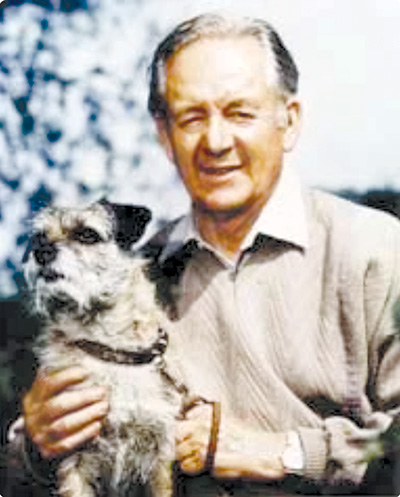

As you read this issue of Insights, you might be curled up on the couch with a furry friend. You two sit in the same house, perhaps enjoying the same breeze from an open window. This morning you walked a familiar sidewalk together or played with a favorite toy on a string. Later, if they behave, they’ll get a bite of the dinner you’ve cooked for yourself.
The routines we comfortably share with pets not only make them wonderful friends, but the human-esque lifestyle of companion animals makes studying dogs a useful comparison point in understanding pathologies in humans.

“Using companion dogs as animal models offers multiple benefits,” explains Dr. Kimberley Sebastian, who completed a residency in anatomic pathology at the MSU College of Veterinary Medicine in spring 2023. “This is important for cancer research, as dogs share our environment and are subject to the same pollutants, pathogens, and age-related diseases.”
Sebastian, who also completed a master’s degree with the College’s Comparative Medicine and Integrated Biology Program, published research using canine cells in Leukemia last year: “Clonal hematopoiesis of indeterminate potential in the companion dog.” The paper was the first description of genetic mutations involved in clonal hematopoiesis of indeterminate potential (CHIP) in dogs. CHIP is associated with aging in humans and animals alike.
CHIP is a recently discovered condition in humans characterized by a subpopulation of blood cells arising from a single bone marrow stem cell bearing a cancer-associated gene mutation,” says Sebastian. “The risk increases with age, with approximately 10 to 20 percent of the population affected by at least one mutation by 70 years of age.”
Harboring CHIP mutations leads to an increased risk of blood cancers, such as lymphoma and leukemia, and an increase in all-cause mortality, typically due to cardiovascular disease.
“The goal of this research was to develop an appropriate, spontaneous animal model for a devastating human disease,” she says. “The aim of translational research is ultimately to improve the health and welfare of both humans and animals.”
To confirm that CHIP-associated mutations in dogs lead to altered cell behavior, Sebastian and her team generated mutated cell lines using CRISPR-Cas9 genome editing technology. The team cut DNA from canine blood samples to insert the mutated gene. Then, they cloned the cell that they had mutated to develop an entire cell line with an identical mutation.
“This enabled us to observe how quickly the cells grew compared to ‘normal’ cells, and to see if they interacted differently,” says Sebastian. “We found that the mutated cells did grow much faster than the control cells, which is promising, as cancer cells frequently proliferate quicker than normal cells.”
The ultimate result of this line of research could lead to an assay to detect and mitigate disease. “The detection of CHIP in dogs can lead to a better understanding of the human disease and potentially contribute to earlier and easier detection in both humans and dogs,” says Sebastian. “This eventually could lead to appropriate early interventions.”
Sebastian’s career may often situate her in laboratories today, but it began in a rustic setting.

“I am from a working-class family in rural Lancashire where my grandparents had a farm, and for as long as I could remember, I wanted to be like our family farm veterinarian,” recalls Sebastian. “I was the first person in my family to go to university, and I think it was just from sheer determination to be like James Herriot that got me there.” (Herriot was a British veterinarian known for his novels about the discipline—also popularized in the TV adaptation All Creatures Great and Small.)
In 2014, she earned a veterinary degree from the University of Liverpool along with an honors degree in veterinary pathology from the Royal Veterinary College. She then worked as a mixed-practice veterinarian in Lancashire, and later, hopped over the Atlantic Ocean to work as an emergency surgeon in Michigan.
However, Sebastian had been passionate about pathology since veterinary school and hoped to divert her career after a few years in practice.
“Working in pathology allows me to really use the fundamentals of veterinary science and pathogenesis of disease within a wide range of species—this variety is something quite unique to veterinary specialties,” she says.
To put her dreams into action, Sebastian started a clinical pathology residency at Michigan State. She became a board-certified veterinary clinical pathologist in 2021, soon after beginning her anatomic pathology residency. She is currently preparing for the anatomic pathology board exam to become dual-certified.
Sebastian’s next career jump takes her across a body of water smaller than the Atlantic Ocean: Lake Michigan. She is a new assistant professor of pathology at the University of Wisconsin-Madison. Near the shoreline of Madison’s Lake Mendota, she has hopes for her CHIP-related research.
“In the future, we would like to collaborate with other institutions to form a larger database and develop cheaper, quicker assays to detect the mutations,” she says. “In addition, we would like to look for additional evidence of CHIP-associated mutations within genes specific to dogs.”
